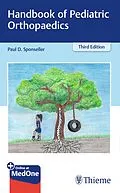User-friendly pediatric orthopaedic surgery reference distills clinical practice into essential facts!
This third edition of Handbook of Pediatric Orthopaedics by the renowned Paul Sponseller builds on prior editions with recent updates and treatment guidelines on pediatric bone and joint disorders. This compact handbook is a succinct, how-to manual covering a diverse spectrum of pediatric orthopaedic procedures. The book is organized by nine chapters, six of which are dedicated to specific disorder categories. An introductory chapter on anatomy and normal childhood development features norms for osseous and motor development, innervation, growth patterns, predictions, and new guidelines for assessing growth at the pelvis, foot, and hand.
Expanded content on skeletal growth, development, and systemic disorders and skeletal syndromes reflects the latest knowledge, such as imaging parameters, clinical treatment standards, and an algorithm for DDH treatment. Cutting-edge advances in the treatment of cerebral palsy, myelodsplasia, and spinal muscular atrophy are detailed in the chapter dedicated to neuromuscular disorders. Pediatric trauma content includes important updates on forearm and femur fractures, an outlined approach to each fracture, and a diagram showing how to reduce each type of Monteggia fracture.
Key Features
- A how-to bulleted guide that walks readers through common procedures including blocks, traction, special casts, aspiration, and arthrograms
- Height and weight multipliers, bone age diagrams, a Lenke classification chart, and the most common lab values are handy clinical references for day-to-day practice
- Clear, concise drawings, bulleted text, charts, graphs, and diagrams enhance clinical understanding
This is a must-have orthopaedic surgery manual for orthopaedic residents, fellows, and practitioners who treat childhood musculoskeletal
Klappentext
Handbook of Pediatric Orthopedics -- now in a fully updated Second Edition -- encapsulates everything an orthopedic surgeon needs to know to make rapid diagnoses and quickly plan treatment for the gamut of common and uncommon pediatric orthopedic problems. The author, a well-respected authority in the field, provides only the most pertinent information on the developmental, genetic, and neurologic etiology of the various conditions. A full chapter concentrates exclusively on core treatment guidelines and algorithms for pediatric trauma management. Each chapter presents information on basic principles, technical skills, and standards of care in an easy-to-reference list format that allows the busy practitioner quick access to key information and thus facilitates faster diagnoses. Features Compiles new data on blocks, traction, special casts, aspiration, and arthogram interpretation Includes 164 drawings, graphs, and charts illustrate important concepts Provides must-know radiographic parameters and clinical tips for key developmental disorders Reviews difficult-to-remember levels of innervation, including for the brachial plexus Numerous charts conveniently list medications and dosages based on weight, route, and frequency Helpful graphs track growth predictions for each region of the skeleton Orthopedic surgeons, residents, or fellows will refer to this highly practical pocket guide on a daily basis. Clinicians, residents, or fellows in pediatrics will also appreciate its brevity and up-to-date coverage.
Inhalt
Chapter 1 Anatomy and Normal Development in Children
Chapter 2 Disorders of Growth and Development in the Extremities
Chapter 3 Disorders of Spinal Growth and Development
Chapter 4 Miscellaneous Disorders of Growth and Development
Chapter 5 Skeletal Syndromes and Systemic Disorders in Pediatric Orthopaedics
Chapter 6 Neuromuscular Disorders in Pediatric Orthopaedics
Chapter 7 Pediatric Trauma
Chapter 8 Normal Values and Medications
Chapter 9 Common Procedures in Pediatric Orthopaedics
